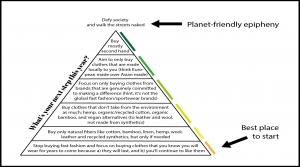What’s your next strategy for sustainable shopping? by Oisin Collishe (first published in West Sussex County Times)
 What’s your next strategy for sustainable shopping? Find out…
What’s your next strategy for sustainable shopping? Find out…
by Oisin Collishe
With the shops re-opening now, can we use this moment to briefly pause and ask ourselves if we need to rush out to buy stuff which we might use for a season then discard?
USEFUL QUESTIONS TO ASK WHEN SHOPPING:
(We don’t necessarily even need to know the answers!)
- How far did this have to travel to get here? (eg Made in China)
- What will happen to it after I’ve done with it? (eg Send to a charity shop or a Humana bin? Or swap with a friend?)
- How much time/energy/water did it take to grow/make this garment?
- Can it be re-made into something else? (eg polyester can be made into pens)
- Will it biodegrade? (eg wool)
- Will it have added micro-plastics or dyes into the water-systems?
USEFUL FACTS TO THINK OF:
- WATER: The fashion industry is the 3rd largest user of water, only behind oil and paper. Cotton is an extremely water-thirsty crop, with the average t-shirt and jeans using up 20,000 litres – an incredible 13 years’ worth of drinking water for one person!
Organic cotton uses 91% less water by comparison as the healthy, rich, soil is able to retain more water, and it also stops the soil blowing away in droughts. A relatively new fabric Tencel runs on a closed loop water system, meaning 99% water that is used is then REUSED! And super-plant hemp produces twice as much fabric as cotton while using 75% less water and returning 60-70% nutrients to the soil.
- TRANSPORTATION: A typical cotton shirt could travel roughly 21,748 miles if the cotton was grown in the US, sent to Bangladesh to be made into a garment, and ended up in stores Germany. That’s equivalent to flying from London to Paris 100 times! That’s a lot of emissions damaging the environment.
- MICRO-PLASTICS: Around 1,900 plastic microfibers can come off of a single synthetic garment; these plastic culprits can be acrylic (jumpers), polyester (t-shirts, trousers… basically everything), polyamide or nylon (sportswear, leggings, tights, bags, jackets).
So, if you’re buying clothing, make it last. ‘Cheap’ items have many big hidden costs in lots of places along the line and “shopping till we drop”, is taking on a whole new meaning…!
https://www.sussexgreenliving.org.uk/love-your-clothes
https://www.sussexgreenliving.org.uk/recycling-zone/
https://ethicalfashioninitiative.org/
HIERARCHY OF NEEDS FOR CONSCIOUS SHOPPERS:
Some of us are woke wised vegan veterans, able to do it all, while some of us are just beginning our journey to help the planet… here’s a fun illustration I made, that I find useful; hopefully you will too!

 West Sussex County Times
West Sussex County Times